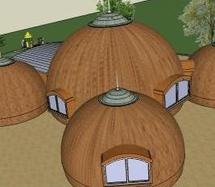High-altitude wind generators based on power propellers
Every 10 meters of height doubles the power . The blades gradually decrease with height. At very large heights, turbines are used.
Non-pilot robotic flying wind dams generation (outline) Flying-and-generating power platforms
At high altitudes, wind power generation is combined with the ability to fly on power platforms for unlimited time. These flying-and-generation platforms may house villages, air farms or production facilities.
Backup energy conservation
Energy is accumulated in the form of compressed air and converted into electrical (and other) forms using a turbine devices.
High altitude power wind generators
WINDHEADS
At a wind speed of 15-17 m/s, with a diameter of 1 m it generates power of 7-10 kW. Power grows with height due to the increase in wind speed (average annual). Every 10 meters of height doubles the power . The blades gradually decrease with height. At very large heights, turbines are used.
1) EFFICIENCY OF THE WINDHEAD 50% (claimed) - 70% -90% (actual)
2) 24 HOUR WORK starting at a wind speed of 1 m/s Five hours of work of the assembled working prototype with a capacity of 2 kW is enough to provide electricity for a country house for a day (at a height of up to 50 meters for Moscow Region)
3) LONG-TERM ACCUMULATION OF THE PRODUCED ENERGY IN THE FORM OF COMPRESSED AIR, 10 TIMES CHEAPER AND 1,5 TIMES LONGER THAN ACCUMULATORS
4) GETTING AND TRANSMISSION OF CALORIC ENERGY
5) GRINDING WORK (MILL), ENERGY IS ENOUGH FOR GRINDING SAND AND STONES
So, in addition to generating electricity, in place
Heat / Cold generation
Atmospheric water generation
Compressed air generation
Mechanical rotation energy generation
Grinding - material restructuring
Using wind energy, one can grind ordinary sand to a particle size of 5 microns, add a weak alkali solution in the water - the result is cementless concrete of class 500
NATURAL AND ARTIFICIAL WINDS
The most important characteristic that determines the energy value of wind is its average annual speed. It has been established that the average annual wind speed under the conditions of a weather station noticeably changes in the territory of Moscow Region and amounts to 3.3-5.5 meters per second.
An important factor is height. Wind energy is proportional to wind speed in the third degree (in a cube). Thus, if the wind speed has doubled, then the wind energy will increase by 8 times (2x2x2 = 8). Wind speed increases with altitude, i.e. increasing the height of the power plant can greatly increase energy efficiency.
There are two main categories of winds - natural and artificial. Natural winds are divided into industrial (from 10 m / s) and non-industrial (up to 10 m / s). So, for the private use of wind turbines in the Moscow region, a mast height of 45 meters is recommended for a wind head.
Artificial winds - winds that are produced from work and operation of:
propellers
pumps compressors
fans
ductwork.
Artificial winds are also of interest to optimize energy resources.
ENGINES
Bondarev propeller with a diameter of 1 meter is able to develop a vertical thrust of 150 kg at a speed of motor rotation of 4000 rpm. With an increase in rpm, the thrust increases. It forms a supersonic flow, which allows to accelerate aircraft in the horizontal direction to supersonic speed.
The proposed design significantly exceeds the existing propeller propellers in terms of efficiency and is several times cheaper than they are in production, half smaller in size, with the same traction, and 2-3 times lighter than analogues. The design of the propeller, in the form of a closed cone, of concave blades allows the screw to be made of a thin composite relative to its size, without profiling their section in width and length.
The inclination of the blades in the direction of the base of the propeller cone produces a gentle compression of centrifugal flows compared to the screws in the nozzles, forming to the propeller axis a relatively uniform and sharply directed flow of increased density and, accordingly, the exit velocity.
The number of blades and their angle of attack, angular, linear and radius sizes of the screw and its elements are determined by the output power and speed on the shaft.
Counter rotation - birotor. The air flow rate in the proposed birotor move is 50% higher than in conventional engines. With the exception of the first stage, the angle of attack in the new mover is always less than in traditional designs, as a result of which the risk of stall modes is completely eliminated, ideal conditions are created for a stable gas-dynamic flow, and the engine operation reliability is greatly increased.
Only on the counter-rotation of the engine and crankshaft will the aircraft save an additional about 45% more fuel.
UAV
Flying
Aboveground
Underground (moving through underground tunnels is like a subway)
Surface
Underwater
Mini hydro power plants (pontoon)
Hydro wheel with a diameter of 1.5 meters based on the Bondarev propeller gives an output power of 15 kW.







